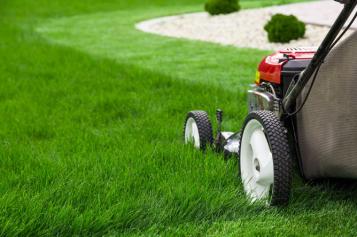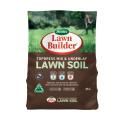An expanse of green grass is one of the great traditions of the typical Kiwi garden. It's hard to imagine a home in the suburbs without the 'show' lawn in front and the family-sized cricket pitch out the back.
From the quarter acre block to the inner city terrace courtyard, they’ve long been a source of great pleasure and, lets be honest, pride.
Taking care of your lawn and keeping it looking its best is easy - especially when you have the right lawn care products to help.
Here’s our simple guide to lawn care and maintenance fundamentals. Get top tips for keeping your grass green, knowing when to mow and fertilise, and applying key nutrients for a lush backyard.
Lawn cutting techniques and considerations
- How long should your grass be?
Go for ‘foot feel’. Trim your grass so it feels comfortable with a little bit of spring under bare feet. - Never mow too low.
You may think you’re getting the jump on growth, but the grass will most probably grow back faster, may develop patchiness and ultimately you’ll damage your lawn. - Avoid watering immediately before or after mowing.
- Mow the lawn in the morning or afternoon.
Avoid the hottest times of day to minimise lawn stress. - A quality cut comes from a well maintained mower.
Service your mower regularly. Ensure the disc and under-deck are kept clean, the blades are clean and sharp and the engine oil and spark plug are changed as per the service book - Empty the catcher frequently.
Don't allow the catcher to fill right up. Empty it before it is completely full, otherwise your mower will sink in with the extra weight giving the grass an uneven cut.
How and when to water lawn
A healthy lawn that is regularly fed, maintained and mown will be able to tolerate dry conditions quite well. However, there will always be times when it needs a bit of extra water.
The key to good watering is to ensure it is both effective and efficient.
- Watering early in the day is best. If you water in the evening, the grass will stay wet overnight, creating humidity which could lead to fungal diseases.
- Don’t water when it’s windy.
- Aim for deeper moisture penetration by watering less often, more slowly and for longer, to encourage deeper roots.
- When using a sprinkler, fit a mechanical tap timer to turn the tap off after a pre-determined time so you don't waste water.
- Invest in a quality lawn sprinkler with adjustable patterns so you don’t waste water on paths and drives.
The importance of fertilising your lawn
Fertilising your lawn is quite possibly the easiest task you need to do to gain a perfect lawn.
Apply a Scotts Lawn Builder Slow Release fertiliser and your lawn will not only become greener but it will also be tougher and more able to resist everything from dry conditions to weed invasion.
Regular feeding is so easy and has all these benefits, yet surprisingly as few as one in four homeowners fertilise their lawns!
If you only perform one maintenance task, aside from mowing, then make it fertilising. It will take less than 10 minutes for the average lawn and will reward you for months.
Lawn fertilising tips
- Before fertilising, rake the lawn to remove leaves and other debris.
- Allow at least two days after mowing before fertilising.
- Wait about a week after feeding before you mow - and leave the catcher off the first time (the fertiliser could all end up in it if it's left on!)
- Select the Scotts Lawn Builder Slow Release fertiliser that’s right for your lawn variety and the time of year.
- Read the directions for use on the bag and make sure you do not apply any heavier than the rate recommended. Over application may result in burning the grass.
- Best results are achieved by feeding three times a year – early spring, early summer (before it gets too hot) and mid to late autumn.
- Even coverage is important so ALWAYS use a spreader (handheld or wheeled).
- Follow the directions on the pack for when and how to water after fertilising.
Two in one - fast greening and slow release fertiliser
Not that long ago you had to make a choice – long-term feeding or fast greening.
Trying to achieve both risked damaging your lawn and all manner of potential environmental problems, such as nutrient runoff, overloading the soil with nutrients, damaging the soil chemistry and altering the pH. But not anymore!
Scotts Lawn Builder Extreme Green lets you have the best of both worlds. You can fertilise on Wednesday, your lawn will be emerald green by the time your guests arrive for the barbie on Saturday and best of all, you won’t need to feed again for three months. You will need:
- Leaf rake
- 4kg bag of Scotts Lawn Builder Extreme Green Granular Fertiliser
- Fertiliser spreader (handheld or wheeled)
Step 1
Calculate amount of fertiliser you’ll need by measuring your lawn in square metres (one large stride = 1 metre approx). Read the directions for use on the bag to see how many grams per square metre to apply, then add the appropriate quantity to spreader hopper. Set the spreader to the correct aperture using the spreader setter information on the bag.
Step 2
Walk the full area of your lawn while spreading fertiliser, following a pattern that allows slight overlap on the edges of the spread. It's often suggested you apply half the fertiliser in a north-south direction over the entire area and the other half in an east-west direction, to obtain even coverage.
Tip: If you’re using a hand-held spreader you may find it easier to walk backwards.
Step 3
Thoroughly water your lawn immediately after spreading to activate the quick greening component or, better still, time your application for just before rain if it is forecast.
The importance of lawn aeration
Even with just normal foot traffic, the soil under your lawn can become compacted, making it harder for grass roots to penetrate and breathe. It also becomes more difficult to get nutrients and water down to the root zone.
Compaction problems typically appear as worn areas that are slow to repair themselves or spreading dead patches. All round poor performance of the lawn may also be an indicator. Fixing compaction problems is pretty simple. You will need:
- Spring-tined lawn rake
- Garden fork or spiked lawn roller
- Washed river sand or Scotts Lawn Builder Lawn Soil
- Scotts Lawn Builder lawn fertiliser (type appropriate for your lawn or purpose)
Step 1
With a metal tined lawn or leaf rake, vigorously rake the lawn to remove all dead grass and other material.
Step 2
For smaller areas: Grab a sturdy garden fork and push it around 5 cm into the soil then gently rock back-and-forth to open the holes up. Continue over the whole lawn area at around 10cm spacings.
For larger lawns: Hire a spiked lawn roller, part fill it with water and then roll over the whole lawn - you’ll find it easier to drag than push.
Step 3
Spread Scotts Lawn Builder Lawn Soil over the area and then, if not previously applied, spread an appropriate Scotts Lawn Builder lawn fertiliser. Rake this mix in well before watering.














